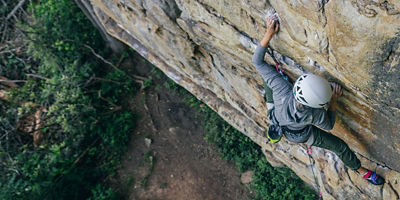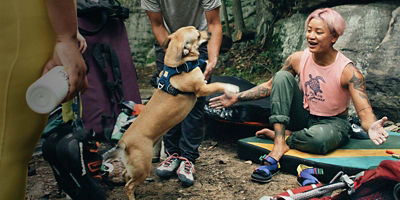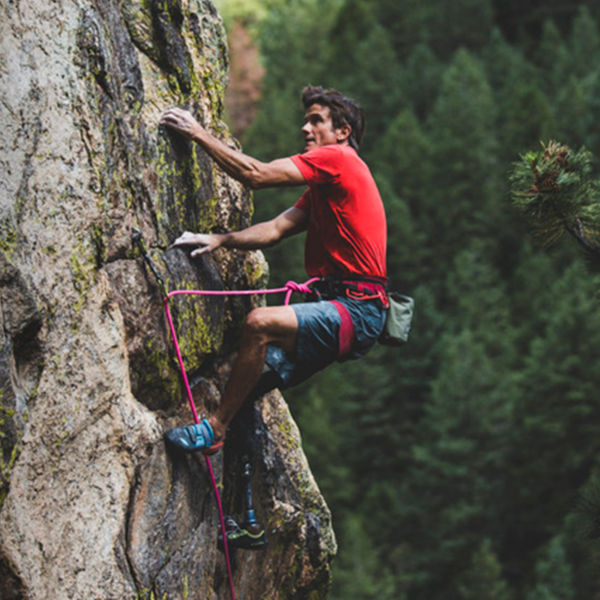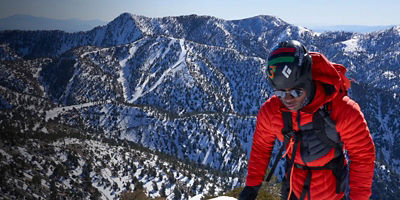
You look high and low, but there’s nowhere to place a cam or even the smallest stopper. In such a scenario, all your traditional anchor-building tricks become suddenly useless. That’s when it’s time to get creative.
Boulders, trees, and even horns and holes in the rock are all valuable sources of protection, or “pro,” in single-pitch and multi-pitch scenarios alike. When you build an anchor using these features, it’s called a “natural anchor.” Here are a few of the most common methods for building one.
Three Ways To Sling a Tree
We’ll start with a quick caveat: Slinging a big tree is often a safe and simple way to build an anchor, but it shouldn’t necessarily be your first choice. Over time, abrasion from ropes and webbing can destroy bark, which will eventually kill the tree. That said, sometimes there’s just no other option. In that case, consider that big ol’ pine fair game. Here’s three ways to sling it.
To practice these methods, you’ll need:
- 25 feet of 7 mm cordelette tied into a loop with a double fisherman’s knot
- A 60- or 70-meter climbing rope
- 10 meters of static line
- A Prusik loop or an assisted-braking device like a GriGri
- Three locking carabiners
The Figure-Eight on a Bight
This is a great all-purpose trick. It’s suitable for building either multi-pitch or top-rope anchors, or for using trees as protection while leading.
- Throw your cordelette loop (or webbing sling if the tree is small enough) around the base of the trunk. Make sure the fisherman’s knot (or webbing bartack) is behind the trunk and out of the way.
- Pull the ends of the cordelette toward you until they’re even. Lay them atop one another.
- Tie a figure-eight on a bight, incorporating all strands in the knot.
- The resulting two-stranded loop is your masterpoint. Clip a locking carabiner here for your personal tether.
The Bowline-Figure-Eight Combo
If you only have small trees at your disposal, it’s best to sling at least two. For top-rope anchors atop a cliff, consider this setup.
- Tie a bowline knot around your first tree with static line. (Remember to back it up.)
- Pull up several armfuls of slack—at least double the distance between you and the cliff’s edge. Tie a large overhand knot on a bight here. This is your safety knot.
- Attach yourself to the rope between the bowline and your safety knot with either a Prusik hitch attached to your belay loop with a locking carabiner, or an assisted-braking device like a GriGri.
- Adjusting your friction hitch or belay device as needed, move toward the cliff’s edge. Decide where you’d like your masterpoint and tie a figure-eight on a bight in your static line at this point. (Make sure you’re not between the masterpoint and bowline when you tie it or you’ll get stuck.)
- Clip a locking carabiner to the masterpoint, lock it around the middle of your climbing rope, and toss the ends of the rope.
- Slide your friction hitch or belay device along the static line to hike away from the cliff’s edge to your second tree.
- Use webbing or cordelette to sling your second tree. Tie a figure-eight on a bight in the ends of the cordelette and clip a locking carabiner through the loop. Affix the static line to the tree with a clove hitch to form the second leg of your anchor.
- Adjust the clove hitch as necessary to keep your masterpoint hanging slightly below the edge of the cliff.
The Connecticut Tree Hitch
If you reach a belay ledge on a multi-pitch climb and find only a single strong tree available for anchoring, use your climbing rope to tie this quick hitch.
- Pull up a bight of slack from the belay strand. Wrap it around one side of the tree, catching the head of the bight on the other side. Pull it to the center of the trunk.
- Grab the two strands of the bight’s tail end. Pull them toward the front of the trunk and push them through the head of the bight.
- Clip a carabiner through the resulting hole. The spine of the carabiner should pin the tailing strands in place.
- Pull more slack from the belay side of your rope. Tie a figure-eight on a bight here. This is your masterpoint.
- If you’re not switching who leads, have your belayer tie a Connecticut tree hitch with their side of the rope when they reach the ledge. Only untie your original hitch when you’re safely on belay.
Key Tips:
- Any tree you sling should be alive, firmly rooted, and thicker than your thick. Suspect? Give it a shake. If it wiggles at the base, move on.
- Wrap your sling around the base of the tree to minimize the lever force on the roots. Mind your anchor to make sure the sling doesn’t inch upward over time.
- No matter what you use to sling the tree, aim for redundancy: A loop of cordelette is automatically doubled-over, and two girth-hitched slings work, too. Only use your climbing rope if you’re really in a pinch.
- When you pull the masterpoint toward you, the strands that depart from it to wrap around the tree should make an angle of 90 degrees or less. This helps minimize the forces on your anchor.






















